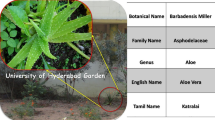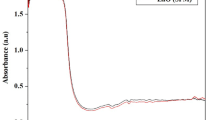Abstract
Macrococcus bovicus was locally isolated from soil and used in the green synthesis of nano-scaling silver (NSAg). It was immobilized on a sodic-montmorillonite clay (MMT1) and cetyltrimethylammonium bromide-modified montmorillonite (MMT2) which was also calcined at 300 °C (MMT3). The NSAg clays were characterized by X-ray fluorescence, Fourier transform infrared spectra, X-ray diffractometry, surface area measurement, UV–Vis spectrometry, scanning electron microscope, transmission electron microscope and thermogravimetric analysis. NSAg was confirmed to be included in the interparticular cavities of the clay sheets and its mechanical stability was evidenced. The antimicrobial activity of the NSAg-modified clays was investigated against Staphylococcus aureus, Escherichia coli and Candida albicans using the cup plate and the plate count techniques. The antimicrobial activity of the NSAg clays was confirmed and attributed to the caging of NSAg in MMT cavities. MMT3 was found to inhibit the microbial growth to as high as 65 % as observed from the plate count method.

Scheme of the biosynthesis of nano-scaling Ag and its immobilization and antimicrobial application









Similar content being viewed by others
References
UN (2013b). Statistical annex: millennium development goals, targets and indicators. http://unstats.un.org/unsd/mdg/Default.aspx. Accessed 24 Mar 2014.
Guidelines for Drinking-water Quality (2008). Incorporating the first and second addenda, recommendations (pp 121, 1) (Third ed., ). Geneva:WHO.
Obasohan, E. E., Agbonlahor, D. E., & Obano, E. E. (2010). Water pollution: a review of microbial quality and health concerns of water, sediment and fish in the aquatic ecosystem. African Journal of Biotechnology, 9(4), 423–427.
Osman, G. A., Hassan, H. M., & Kamel, M. M. (2011). Resistance and sensitivity of some bacterial strains isolated from hospital wastewater and Nile water using chlorination and some antibiotics in Cairo (Egypt). Journal of American Science, 7(9), 1033–1041.
Khandelwal, N., Kaur, G., Kumara, N., & Tiwari, A. (2014). Application of silver nanoparticles in viral inhibition: a new hope for antivirals. Digest Journal of Nanomaterials and Biostructures, 9, 175–186.
Rispail, N., De Matteis, L., Santos, R., Miguel, A. S., Custardoy, L., Testillano, P. S., Risueño, M. C., Pérez-de-Luque, A., Maycock, C., Fevereiro, P., Oliva, A., Fernández-Pacheco, R., Ibarra, M. R., de la Fuente, J. M., Marquina, C., Rubiales, D., & Prats, E. (2014). Quantum dot and superparamagnetic nanoparticle interaction with pathogenic fungi: internalization and toxicity profile. ACS Applied Materials & Interfaces, 6(12), 9100–9110.
Swain, P., Nayak, S. K., Sasmal, A., Behera, T., Barik, S. K., Swain, S. K., Mishra, S. S., Sen, A. K., Das, J. K., & Jayasankar, P. (2014). Antimicrobial activity of metal based nanoparticles against microbes associated with diseases in aquaculture. World Journal of Microbiology and Biotechnology, 30, 2491–2502.
Rizzello, L., Cingolani, R., & Pompa, P. P. (2013). Nanotechnology tools for antibacterial materials. Nanomedicine, 8(5), 807–821.
Velázquez-Velázquez, J. L., Santos-Flores, A., Araujo-Meléndez, J., Sánchez-Sánchez, R., Velasquillo, C., González, C., Martínez-Castañon, G., & Martinez-Gutierrez, F. (2015). Anti-biofilm and cytotoxicity activity of impregnated dressings with silver nanoparticles. Materials Science and Engineering: C, 49, 604–611.
Wijnhoven, S. W. P., Peijnenburg, W. J. G. M., Herberts, C. A., Hagens, W. I., Oomen, A. G., Heugens, E. H. W., Roszek, B., Bisschops, J., Gosens, I., Van De Meent, D., Dekkers, S., De Jong, W. H., Van Zijverden, M., Sips, A. J., & Geertsma, R. E. (2009). Nano-silver—a review of available data and knowledge gaps in human and environmental risk assessment. Anotoxicology, 3(2), 109–138.
Freire, P. L. L., Stamford, T. C. M., Albuquerque, A. J. R., Sampaio, F. C., Cavalcante, H. M. M., Macedo, R. O., Galembeck, A., Flores, M. A. P., & Rosenblatt, A. (2015). Action of silver nanoparticles towards biological systems: cytotoxicity evaluation using hen’s egg test and inhibition of Streptococcus mutans biofilm formation. International Journal of Antimicrobial Agents, 45, 183–187.
Tolaymat, T., El Badawy, A., Genaidy, A., Scheckel, K., Luxton, T., & Suidan, M. (2010). An evidence-based environmental perspective of manufactured silver nanoparticle in syntheses and applications: a systematic review and critical appraisal of peer-reviewed scientific papers. The Science of the Total Environment, 408(5), 999–1006.
Vigneshwaran, N., Kathe, A. A., Varadarajan, P. V., Nachane, R. P., & Alasubramanya, A. (2007). Silver-protein (core-shell) nanoparticle production using spent mushroom substrate. Langmuir, 23, 7113–7117.
Kalimuthu, K., Babu, R. S., Venkataraman, D., Bilal, M., & Gurunathan, S. (2008). Biosynthesis of silver nanocrystals by Bacillus licheniformis. Colloids and Surfaces B: Biointerfaces, 65, 150–153.
Bhainsa, K. C., & D’Souza, S. F. (2006). Extracellular biosynthesis of silver nanoparticles using the fungus Aspergillus fumigatus. Colloids and Surfaces B: Biointerfaces, 47, 160–164.
Mukherjee, P., Roy, M., Mandal, B. P., Dey, G. K., Mukherjee, P. K., Ghatak, J., Tyagi, A. K., & Kale, S. P. (2008). Green synthesis of highly stabilized nanocrystalline silver particles by a nonpathogenic and agriculturally important fungus T. asperellum. Nanotechnology, 19, 075103.
Khan, M., Khan, M., Adil, S. F., Tahir, M. N., Tremel, W., Alkhathlan, H. Z., Al-Warthan, A., & Siddiqui, M. R. (2013). Green synthesis of silver nanoparticles mediated by Pulicaria glutinosa extract. International Journal of Nanomedicine, 8, 1507–1516.
Kovvuru, P., Mancilla, P. E., Shirode, A. B., Murray, T. M., Begley, T. J., & Reliene, R. (2014). Oral ingestion of silver nanoparticles induces genomic instability and DNA damage in multiple tissues, oral ingestion of silver nanoparticles induces genomic instability and DNA damage in multiple tissues. Nanotoxicology. doi:10.3109/17435390.2014.902520.
Jiang, J., Oberdörster, G., & Biswas, P. (2009). Characterization of size, surface charge, and agglomeration state of nanoparticle dispersions for toxicological studies. Journal of Nanoparticle Research, 11, 77–89.
El Badawy, A., Luxton, T., Silva, R., Scheckel, K., Suidan, M., & Tolaymat, T. (2010). Impact of environmental conditions (pH, ionic strength, and electrolyte type) on the surface charge and aggregation of NSAg suspensions. Environmental Science & Technology, 44(4), 1260–1266.
Benn, T. M., & Westerhoff, P. (2008). Nanoparticle silver released into water from commercially available sock fabrics. Environmental Science & Technology, 42, 4133–4139.
Shameli, K., Ahmad, M. B., Yunus, W. M. W., Ibrahim, N. A., Gharayebi, Y., & Sedaghat, S. (2010). Synthesis of silver/montmorillonite nanocomposites using γ-irradiation. International Journal of Nanomedicine, 5, 1067–1077.
Lavorgna, M., Attianese, I., Buonocore, G. G., Conte, A., Del Nobile, M. A., Tescione, F., & Amendola, E. (2014). MMT-supported Ag nanoparticles for chitosan nanocomposites: structural properties and antibacterial activity. Carbohydrate Polymers, 102, 385–392.
Tian, L., Oulian, L., Zhiyuan, L., Liuimei, H., & Xiaosheng, W. (2014). Preparation and characterization of silver loaded montmorillonite modified with sulfur amino acid. Applied Surface Science, 305, 386–395.
Gillott, J. E. (1968). Clay in engineering geology, (Chapter 5) (1st ed., ). Amsterdam:Elsevier.
Vazquez, A., López, M., Kortaberria, G., Martín, L., & Mondragon, I. (2008). Modification of montmorillonite with cationic surfactants. Thermal and chemical analysis including CEC determination. Applied Clay Science, 41, 24–36.
Srinivasan, D., Nathan, S., Suresh, T., & Lakshmana, P. P. (2001). Antimicrobial activity of certain Indian medicinal plants used in folkloric medicine. Journal of Ethnopharmacology, 74, 217–220.
Gupta, D., Khare, S. K., & Laha, A. (2004). Antimicrobial properties of natural dyes against Gram-negative bacteria. Coloration Technology, 120, 167–171.
Duhan, S., Devi, S., & Kumar, S. (2010). Synthesis of composite based on nano sized silver particles hosted on silica networks. International Journal of Electrical Engineering, 2(1), 225–228.
Mie, G. (1908). Beiträge zur Optik trȕber Medien, speziell kolloidaler Metallosȕngen. Annalen der Physik, 25, 377.
Wang, H., Law, N., Pearson, G., van Dongen, B. E., Jarvis, R. M., Goodacre, R., & Lloyd, J. R. (2010). Impact of silver (I) on the metabolism of Shewanella oneidensis. Journal of Bacteriology, 192(4), 1143–1150.
Zhu, J., Zhu, L., Zhu, R., & Chen, B. (2008). Microstructure of organobentonites in water and the effect of steric hindrance on the uptake of organic compounds. Clays and Clay Minerals, 56(2), 144–154.
(1995) Composition and mineralogy of clay minerals. In: B. Velde (Ed.), Origin and mineralogy of clays (pp. 27–33). Berlin: Springer-Verlag.
Lagaly, G., Ogawa, M., & Dekany, I. (2006). Clay mineral organic interactions. In F. Bergaya, B. K. G. Theng, & G. Lagaly (Eds.), Handbook of clay science (pp. 309–377). Amsterdam: Elsevier.
He, H., Frost, R. L., Bostrom, T., Yuan, P., Duong, L., Yang, D., Xi, Y., & Kloprogge, J. T. (2006). Changes in the morphology of organoclays with HDTMA+ surfactant loading. Applied Clay Science, 31, 262–271.
Grim, R. E. (1968). Clay mineralogy (p. 288). New York, USA:Mc Graw Hill Company.
Ferraro, J. R. (1982). The Sadtler infrared spectra handbook of minerals and clays (pp. 354–356). Philadelphia, Pennsylvania:Sadtler Research Laboratories.
Letaief, S., Casal, B., Aranda, P., Martín-Luengo, M. A., & Ruiz-Hitzky, E. (2003). Fe-containing pillared clays as catalysts for phenol hydroxylation. Applied Clay Science, 22, 263–277.
Lambert, J. B., Shurvell, H. F., Lighter, D. A., & Cooks, R. G. (1998). Organic structural spectroscopy. New Jersey:Prentise-Hall.
Fatimah, I., & Huda, T. (2013). Preparation of cetyltrimethylammonium intercalated Indonesian montmorillonite for adsorption of toluene. Applied Clay Science, 74, 115–120.
Harris, D. J., Bonagamba, T. J., & Schmidt-Rohr, K. (1999). Conformation of poly(ethylene oxide) intercalated in clay and MoS2 studied by two-dimensional double-quantum NMR. Macromolecules, 32, 6718–6724.
Xie, W., Gao, Z., Pan, W., Huner, D., Singh, A., & Vaia, R. (2001). Thermal degradation chemistry of alkyl quaternary ammonium montmorillonite. Chemistry of Materials, 13(9), 2979–2990.
Zhu, Z. J., Wang, T., Zhu, R., Ge, F., Yuan, P., & He, H. (2011). Expansion characteristics of organo montmorillonites during the intercalation, aging, drying and rehydration processes: effect of surfactant/CEC ratio. Colloids and Surfaces A: Physicochemical and Engineering Aspects, 384(1–3), 401–407.
Kora, A. J., Beedu, S. R., & Jayaraman, A. (2012). Size-controlled green synthesis of silver nanoparticles mediated by gum ghatti (Anogeissus latifolia) and its biological activity. Organic and Medicinal Chemistry Letters, 2, 17.
Lin, J. J., Lin, W. C., Li, S. D., Lin, C. Y., & Hsu, S. H. (2013). Evaluation of the antibacterial activity and biocompatibility for Ag NPs immobilized on nano silicate platelets. ACS appl Mathematical Intelligence, 5, 433–443.
Incoronato, A. L., Conte, A., Buonocore, G. G., & Del Nobile, M. A. (2011). Agar hydrogel with silver nanoparticles to prolong the shelf life of Fior di Latte cheese. Journal of Dairy Science, 94, 1697–1704.
Bezic, N., Skocibusic, M., Dinkic, V., & Radonic, A. (2003). Composition and antimi-crobial activity of Achillea clavennae L. essential oil. Phytotherapy Research, 17, 1037–1040.
Author information
Authors and Affiliations
Corresponding author
Rights and permissions
About this article
Cite this article
Abdel-Aziz, M.S., Abou-El-Sherbini, K.S., Hamzawy, E.M.A. et al. Green Synthesis of Silver Nano-particles by Macrococcus bovicus and Its Immobilization onto Montmorillonite Clay for Antimicrobial Functionality. Appl Biochem Biotechnol 176, 2225–2241 (2015). https://doi.org/10.1007/s12010-015-1710-3
Received:
Accepted:
Published:
Issue Date:
DOI: https://doi.org/10.1007/s12010-015-1710-3




